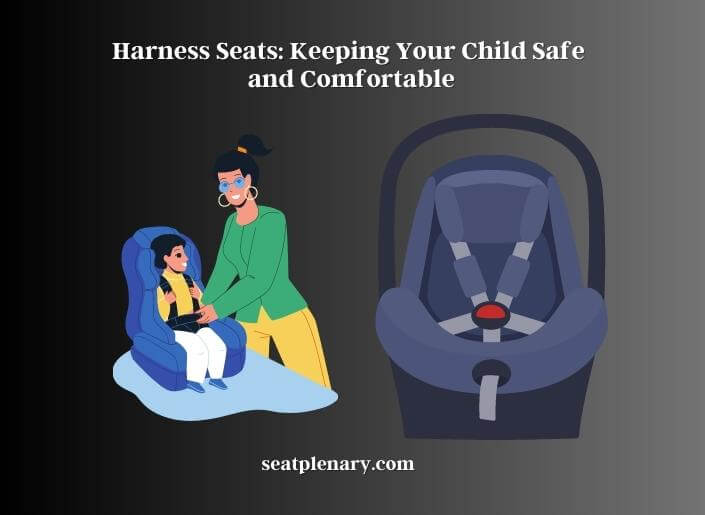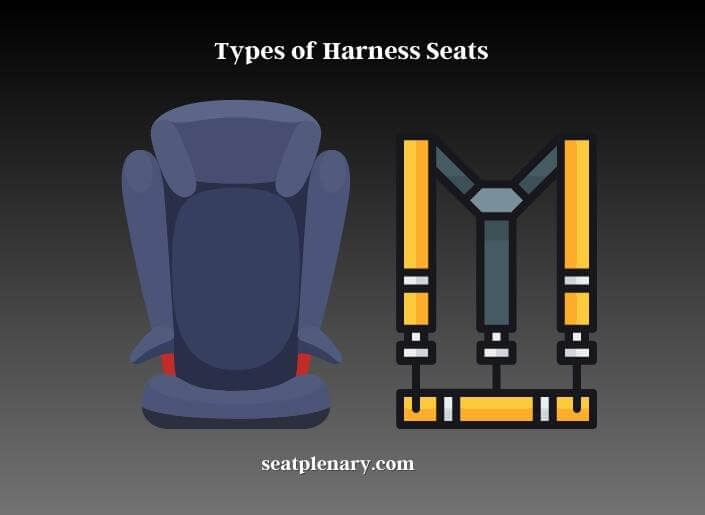As a parent, you want to ensure the safety and comfort of your child at all times, especially when traveling in a vehicle. Road accidents are a leading cause of injury and death among children, which is why it’s important to take extra precautions to protect them. One of the most effective ways to do this is by using a harness seat.

Harness seats are designed to keep your child secure and comfortable while traveling in a vehicle. They provide added protection in case of an accident and are much safer than regular seats. Harness seats are also more comfortable for your child and can be adjusted to fit their size and shape. They come in different types, each with its own set of features and benefits.
Harness seats
A harness seat is a type of car seat that uses a harness system to secure a child in the seat. It typically has a 5-point harness that goes over the child’s shoulders, around the waist, and between the legs to hold them securely in the seat. This type of seat is designed to provide added protection for young children in the event of a car accident. Harness seats are often recommended for children who are too small for a booster seat or who have not yet outgrown the weight and height limits of a forward-facing car seat with a harness.
Types of Harness Seats
There are different types of harness seats available, each designed for a specific age group and weight range. It’s important to choose the right type of harness seat for your child to ensure their safety and comfort while traveling. Here are some of the most common types of harness seats:
Rear-Facing Infant Seats
These harness seats are designed for infants up to 2 years of age or until they reach the maximum weight and height allowed by the seat. Rear-facing seats provide added protection for your child’s head, neck, and spine in case of an accident. They are typically installed in the back seat of the car and come with a handle for easy carrying.

Convertible Seats
These seats can be used both rear-facing for infants and forward-facing for older children. They are designed for children up to 40 pounds in weight and can be adjusted as your child grows. Convertible seats provide a cost-effective solution for parents who want to use the same seat for an extended period.
Combination Seats
These seats can be used as harness seats for younger children and as booster seats for older children. They are designed for children between 20-65 pounds in weight and provide a seamless transition from a harness seat to a booster seat.
Booster Seats
Booster seats are designed for children who have outgrown their harness seats but are still too small to use the car’s seat belt safely. They are typically used for children between 40-100 pounds in weight and provide added height to ensure the seat belt fits properly.
All-In-One Seats
These seats are designed to accommodate children from infancy to toddlerhood and beyond. They can be used as rear-facing, forward-facing, and booster seats, providing a complete solution for parents who want to invest in one seat for their child’s entire car seat journey.
Factors to Consider When Choosing a Harness Seat
Choosing the right harness seat for your child can be overwhelming, but there are several factors you should consider to ensure you make an informed decision. Here are some of the key factors to keep in mind:
Age and Weight
Harness seats are designed for specific age groups and weight ranges. It’s essential to choose a seat that is appropriate for your child’s age and weight to ensure their safety and comfort.
Type of Vehicle
Different harness seats are designed to fit different types of vehicles. It’s important to consider the make and model of your vehicle to ensure the seat you choose can be properly installed and secured.
Ease of Installation
Proper installation is crucial for the safety of your child. Choose a harness seat that is easy to install and comes with clear instructions. Some seats come with a base that can be left in the car, making it easier to install and remove the seat.
Adjustability
Harness seats should be adjustable to accommodate your child’s growth and changing needs. Look for seats with adjustable straps and headrests to ensure a proper fit.
Safety Features
Harness seats come with different safety features, such as side-impact protection and energy-absorbing foam. Consider the safety features of each seat and choose one that provides maximum protection for your child.
Comfort
Your child will be spending a lot of time in their harness seat, so it’s important to choose one that is comfortable. Look for seats with padding and adjustable recline positions to ensure your child is comfortable and supported.
Budget
Harness seats come in different price ranges. Consider your budget and choose a seat that fits your needs and provides the necessary safety features.
Installation Tips
Installing a harness seat correctly is essential for ensuring your child’s safety while traveling in a vehicle. Here are some tips to help you install your child’s harness seat properly:
| Read the instructions | Before installing the seat, read the instructions carefully to ensure you understand the proper installation process. Each harness seat may have specific installation requirements, so it’s important to read the instructions provided by the manufacturer. |
| Choose the right location | The harness seat should be installed in the back seat of the vehicle, away from any airbags. If you have more than one child, place the younger child in the center of the back seat to provide added protection. |
| Secure the seat tightly | The harness seat should be secured tightly to the car’s seat using either the LATCH system or the car’s seat belt. Make sure the seat does not move more than an inch in any direction. |
| Position the harness correctly | The harness straps should be positioned at or just below your child’s shoulders. The straps should be snug but not too tight, allowing you to fit one finger between the strap and your child’s collarbone. |
| Check the recline angle | The recline angle of the harness seat should be adjusted to ensure your child’s head does not flop forward. Follow the manufacturer’s guidelines for the proper recline angle based on your child’s age and weight. |
| Double-check everything | Once the harness seat is installed, double-check everything to ensure it’s secure and safe for your child. Check the straps, buckles, and overall stability of the seat. |
| Seek professional help | If you’re unsure about the proper installation of your child’s harness seat, seek professional help. Many car dealerships and police stations offer free installation assistance to ensure your child’s seat is installed correctly. |
Maintenance and Care
To ensure your child’s harness seat remains safe and functional, it’s important to properly maintain and care for it. Here are some tips for maintaining and caring for your child’s harness seat:
Clean the seat regularly: Children can be messy, so it’s important to clean the harness seat regularly. Follow the manufacturer’s instructions for cleaning the seat cover and straps.
Check for damage: Before each use, check the harness seat for any signs of damage, such as cracks, tears, or loose stitching. If you notice any damage, replace the seat immediately.
Keep the seat dry: Avoid leaving the harness seat in the sun or rain for extended periods as this can damage the seat’s materials. Keep the seat in a dry, cool place when not in use.
Store the seat properly: If you’re not using the harness seat for an extended period, store it in a safe place where it won’t be damaged or exposed to extreme temperatures.
Follow expiration dates: Harness seats have expiration dates, usually six to ten years from the date of manufacture. Check the expiration date on your child’s harness seat and replace it if it has expired.
Register the seat: Many harness seat manufacturers offer registration programs to notify you of any safety recalls or updates. Register your child’s harness seat to stay up-to-date on any safety information.
Follow the manufacturer’s guidelines: Always follow the manufacturer’s guidelines for use, installation, and maintenance of your child’s harness seat. Failure to follow these guidelines can compromise the safety of the seat.
Common Mistakes to Avoid
When it comes to using a harness seat for your child, there are some common mistakes that many parents make. Avoiding these mistakes can help ensure your child’s safety while traveling in a vehicle. Here are some common mistakes to avoid:
Using an Expired Seat
As mentioned earlier, harness seats have expiration dates. Using an expired seat can compromise the safety of the seat, so make sure to replace it when it has expired.
Using a Damaged Seat
Similarly, using a damaged seat can also compromise its safety. If you notice any damage to your child’s harness seat, replace it immediately.
Incorrect Installation
One of the most common mistakes is incorrectly installing the harness seat. Follow the manufacturer’s instructions carefully and seek professional help if you’re unsure about the installation process.
Loose Harness Straps
The harness straps should be snug but not too tight. If the straps are too loose, your child can move around in the seat, increasing the risk of injury in an accident. Make sure to adjust the straps properly for a secure fit.
Incorrect Placement
The harness seat should be placed in the back seat of the vehicle, away from any airbags. Placing the seat in the front seat or near an airbag can be dangerous for your child.
Bulky Clothing
Dress your child in thin, snug-fitting clothing while in the harness seat. Bulky clothing can interfere with the proper fit of the straps and compromise the safety of the seat.
Using Accessories
Avoid using accessories, such as headrests or seat liners, that are not recommended by the manufacturer. These accessories can interfere with the proper fit and function of the harness seat.
Conclusion
In conclusion, harness seats are an essential safety feature for young children when traveling in a vehicle. By using a harness seat that fits your child properly and following the manufacturer’s guidelines for installation, maintenance, and care, you can ensure your child’s safety while traveling. It’s important to be aware of common mistakes that many parents make when using a harness seat and to avoid these mistakes to ensure the seat functions properly in the event of an accident.
Remember to check the expiration date of the harness seat and to replace it when it has expired. Regularly inspect the seat for any signs of damage and avoid using any accessories that are not recommended by the manufacturer. By following these tips and guidelines, you can help keep your child safe and secure while traveling in a vehicle.
Investing in a quality harness seat is an investment in your child’s safety, and it’s worth taking the time to research and choose the right seat for your child’s needs. With proper use and care, a harness seat can provide peace of mind and help keep your child safe on the road.
